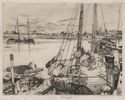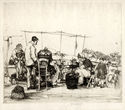
19th, 20th & 21st Century Fine Prints
707-546-7352 · fax 707-546-7924 · web: www.annexgalleries.com · email: artannex@aol.com
John William Winkler Biography
John William Winkler
American
1894–1979
Biography
Painter, printmaker, draftsman and craftsman, John William Joseph Winkler was born in Vienna, Austria on July 30, 1894. His family was of old money and military lineage and there appears to have been an expectation for Winkler to become a part of the Viennese government. When it became clear that young Winkler was bent on seeing America before settling down to such a future (claiming to have had "visions" of the Wild West), they agreed to fund one year's worth of travel to the United States. Documents written by Winkler state that he arrived in New York at the age of 16-1/2 and, according to Master of Line (Millmer, Mary and Bohn, Dave. Capra Press, 1994), he had enrolled in the Mark Hopkins Institute - now the San Francisco Art Instute - in San Francisco, California by November 1, 1912. Winkler would never return to Austria nor see his family again.
At Mark Hopkins he was introduced to etching by Frank Van Sloun. His first goal had been to learn "cartooning", but the apt pupil soon changed to a more realistic style inspired by the American painter-etcher movement as well as European Modernism. The Institute issued Winkler a lifelong scholarship, allowing the popular student to continue attending courses as needed, supporting himself as a lamplighter in Chinatown. This and Telegraph Hill, both culturally rich areas of the growing city, provided him with endless inspiration for his etchings. While on location, he was known to draw directly on prepared plates, including his earliest known series of architectural images documenting the construction of City Hall in 1914.
Departing for Europe in 1922, Winkler lived first in Paris and then in London over a period of seven years, sketching and drawing as he went. He not only drew cities and villages, but he appears to have visited the Lascaux caves of Dordogne with their Paleolithic-era wall paintings, as well, which would inspire a series of conte-crayon drawings of the subject. After returning to California in 1928 he reworked many of his city and country life images for etchings, and then focused his attention on California landscapes, creating a series of images of the Sierra Nevadas. Additionally, he began studying woodworking, which would replace printmaking for a time. In the early 1970s, he revived his interest in the etching medium, though many of these were not published before his death.
He was a member of the Chicago Society of Etchers, The California Society of Etchers, the Society of American Graphic Artists, the San Francisco Art Association and an honorary member of the Printmakers Society of California; in 1936, he was elected an Associate in the National Academy of Design and full Academician in 1951. One of the highest tributes Winkler received was from his friend, John Taylor Arms, who proclaimed Winkler to be the "master of line," the "master of us all."
In 1955, there was an exhibition of his etchings in Holland and he had a solo exhibition in 1974 at the Achenbach Foundation. Winkler is represented in the collections of the Achenbach Foundation, the Smithsonian American Art Museum, the Library of Congress, the Boston Public Library, the Metropolitan Museum, the New York Public Library, the Oakland Museum, the San Francisco Public Library and the Victoria and Albert Museum.
J.W. Winkler (known as "Winks") died in El Cerrito, CA in January 26, 1979.









